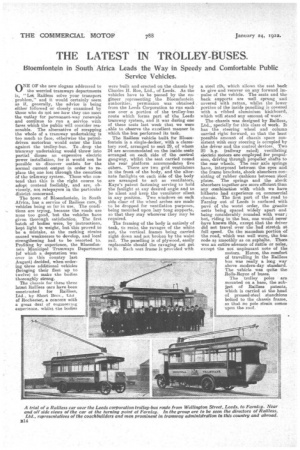THE LATEST IN TROLLEY-BUSES.
Page 10

If you've noticed an error in this article please click here to report it so we can fix it.
Bloemfontein in South Africa Leads the Way in Speedy and Comfortable Public Service Vehicles.
ONE OF the new slogans addressed to the worried tramways departments is, "Let Railless solve your transport problem," and it would certainly seem as if, generally, the advice is being either followed or closely examined by those who do not see how they can meet the outlay for permanent-way renewals and continue to rim a service with fares which the public will consider reasonable. The alternative of scrapping the whole of a tramway undertaking is too much to face, otherwise the petroldriven motorbus would enter the lists against the trolley-bus. To drop the tramway undertaking would throw into partial disuse an expensive electric power installation, for it would not he possible to discover outlets for the normal current output in order to replace the one lost through the cessation of the trIlmway system. Those .who contend that this is the right coarse to adopt contend foolishly, and are, obviously, not ratepayers iu the particular district concerned.
The town of Bloemfontein. in South Africa, has a service of Rail/less cars, 9 vehicles being so far in use. The conditions are trying, because the roads are none too good, but the vehicles have given thorough satisfaction. The first batch of bodies were, by instructions, kept light in weight, but this proved to be a mistake, as the racking strains caused weaknesses to develop, and local strengthening had to be resorted to Profiting by experience, the Bloemfontein Municipal Tramways Department (of which a deputation was over in this country last August) decided, when ordering three additional vehicles (bringing their fleet up to twelve) to make the bodies thoroughly strong.
The chassis for these three latest Railless oars have been constructed for Railless, Ltd., by Short Bros., Ltd of Rochester, a concern with a great deal of engineering experience, whilst the bodies
were built and erected on the chassis by Charles H. Roe, Ltd., of Leeds. As the vehicles have to be passed by the engineer representing the Bloemfontein authorities, permission was obtained from the Leeds Corporation to run each one over a portion of the trolley-bus route which forms part of the Leeds tramway system, and it was during one of these tests last week that we were able to observe the excellent manner in which the bus performed its task.
The Railless vehicle built for Bloemfontein is a single-decker, with a clerestory roof, arranged to seat 29, of whom 24 are accommodated on the inside seats arranged on each side of the central gangway, whilst the seat carried round the rear platform accommodates five others. There are two grid veetilators in the front of the body, and the alternate fanlights on each side of the body are arranged to act as ventilators, Kaye's patent fastening serving to hold the fanlight at any desired angle and to be silent and keep the ventilator silent in any position. Two windows on each side clear of the wheel arches are made to be dropped for ventilation purposes, being mounted upon lazy tong supports, so that they stay wherever they may be required.
The framing of the body is entirely of teak, to resist the ravages of the white ant, the vertical frames being carried right down and not broken by the waist rail. The panelling is of plywood, easily replaceable should the ravaging ant get to it. Each seat frame is provided with
a steel rib, which allows the seat back to give and recover on any forward impulse of the vehicle. The seats and the back supports are well sprung and covered with rattan, whilst the lower portion of the inside panelling is covered with a ribbed aluminium kickboard, which will stand any amount of wear.
The chassis was designed by Railless, Ltd., specially for this class of work. It has the steering wheel and column carried right forward, so that the least possible amount of chassis space con• eastent with easy steering is occupied by the driver and the control devices. Two 20 h.p. (railway rated) ventilating electric motors are employed for propulsion, driving through propeller shafts to the rear wheels. The rear axle springs have, interposed between the eyes and the frame brackets, /shock absorbers consisting of rubber cushions between steel plates. The springs and the shock absorbers together are more effictent than any combination with which we have hitherto had experience on commercial chassis. The first part of the road to Fernley out of Leeds is surfaced with pave of the worst order, the granite setts being spaced widely apart and being considerably rounded with wear; but, riding in the bus, one would never have known this, except that the driver did not travel over the bad stretch at Lull speed. On the macadam portion of the road, which was well wore, the bus rode as smoothly as on asplialte. There was an entire 'absence of rattle or noise, except the not unpleasant note of the motors. Het10/3, the comfort of travelling in the Railless bus was really a long way above modern-day standard. The vehicle was quite the Rolls-Royce of buses.
The trolley poles are mounted on a base, the subject of Raffles& patents, which is carried at the head of pressed-steel stanchions bolted to the chassis frame, so that no pole strain comes upon the roof.






























